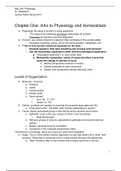Bisc 330: Physiology Dr. Jekabsons Lecture Notes Spring 2019 1 Chapter One: Intro to Physiology and Homeostasis ● Physiology: the study of function in living organisms ○ “The study of all underlying processes responsible for function” ○ Processes are dynamic and time -dependent ● Function: any activity inherent to organism that contributes to the overall viability ○ Examples: breathing, eating, cell -to-cell communication, metabolism, etc. ● **This is how function should be explained on the tests ○ Example question: Why does breathing rat e increase with exercise? ○ Use the mechanistic explanation rather than the teleological explanation ■ Teleological explanation: to meet bodily need ■ Mechanistic explanation: series of cause and effect events that cause the change in function to occur ● Identify components involved in function ● Explain properties of each component ● Explain how components interact with each other Levels of Organization A. Molecular / chemical: a. Proteins* b. Lipids* c. Carbohydrates d. Nucleic acids e. Small solutes* i. Ions: Na+, K+, Ca2+ ii. Gases: O 2, CO B. Cellular: smallest unit capable of executing all processes associated with life a. Total adult human: 100 trillion cells *function depending on protein* C. Tissue: closely associated group of cells having similar structure and function a. Epithelial: cover or line any surface of lumen, form boundaries i. Most diverse type b. Nervous: groups of neurons, specialized to generate and transmit electrical signals c. Muscle: ge nerate force by contraction d. Connective: Form insoluble extracellular matrix *Sometimes in physiology, tissue and organ are used interchangeably* D. Organ: Two or more primary tissues organized in a way that yields one or more “new” functions. Restricted to st ructures found in body cavities (thoracic and abdominal) a. “New” functions refer to any function that a tissue cannot do on its own Bisc 330: Physiology Dr. Jekabsons Lecture Notes Spring 2019 2 E. Body System: Two or more organs organized in a way to yield one or more “new” functions not possible by any one organ a. Eleven b ody systems: emphasize in this course → endocrine, nervous, muscular, cardiovascular, and respiratory i. Pg. 8 & 9, fig. 1.5 depicts all body systems F. Organismal: Collection of body systems forming free, independent living organism Fluid Compartments A. Intracellular fluid: “cytoplasm” ~⅔ total fluid volume B. Extracellular fluid (ECF): ~⅓ total fluid volume a. Plasma: fluid compartment of blood (55%) b. Interstitial (IF): fluid within an organ, surrounding the cells, this is the environment cells are exposed to c. *Lymph: fluid within lymphatic vessels, similar in composition to interstitial fluid d. *Transcellular: fluid formed by transport activity of epithelial tissue i. Ex. sweat, tears, urine, saliva, breast milk, digestive secretion, etc. **Not in the book Control o f Internal Environment ● Claude Bernard (1860 -1880) came to conclusion that constancy of internal environment is necessary condition for free and independent life ● Walter Cannon (1930s) “homeostasis” ○ Homeostasis: tendency of animal’s internal environment to remain constant over its lifetime ● Internal environment generally referring to the ECF, which consist of the plasma and interstitial fluid 𝑓𝑙𝑢𝑖𝑑 →𝑉𝑜𝑙 𝑜𝑓 𝐻2𝑂 + [𝑎𝑙𝑙 𝑠𝑜𝑙𝑢𝑡𝑒𝑠 ] ○ All solutes refers to nutrients, waste, ions, and gases ● Constancy of chemical & physical properties of ECF ○ Physical properties: temperature, blood pressure, etc. ○ Physical + chemical properties → physiological variables ■ Each physiological variable has a set poi nt → magnitude around which a variable fluctuates. The body works to return to this variable when the magnitude is disturbed. Organs and body systems function as control systems which work to minimize changes in the magnitude of the physiological variable Bisc 330: Physiology Dr. Jekabsons Lecture Notes Spring 2019 3 Control System Components 1. Sensor: monitors the magnitude of the variable Communicates with ↴ 2. Integrator: processes information from one or more sensors to determine some output response Communicates with ↴ 3. Effector: activity directly affects the magni tude of a variable Control systems operate as a negative feedback loop which is a process triggered by a change in the magnitude of a variable that triggers a response that opposes change. Two Types of Control Systems A. Intrinsic: all components are found in the same organ a. Minimizes changes in a variable within interstitial fluid of that organ B. Extrinsic: the components of the system ie in two or more organs a. Minimizes changes in blood plasma variable → affects interstitial fluid of all organs b. Nervous system and/or endocrine systems will always be sensor and integrator components for this type of control system Why is homeostasis important? The physiological variable is monitored by a sensor which the integrator processes when it is out of the set range, the effector works to move that variable back to the set point. Bisc 330: Physiology Dr. Jekabsons Lecture Notes Spring 2019 4 Chapter 3: Plasma Membrane & Membrane Potential Membrane Potential ● Membrane potential is the unequal distribution of charge across a membrane. Its units is in millivolts (mV). ○ Plasma membrane potential: ΔѰ p ○ Mitochondrial inner membrane: ΔѰ m ● We can measure the change of plasma membrane potential using: ○ Electrocardiogram (ECG) ○ Electromyog ram (EMG) ○ Electroencephalogram (EEG) How do cells generate and maintain ΔѰ p? 1. Energy -dependent movement of ions across the plasma membrane a. Na+, K+, Cl- 2. Selective diffusion of ions across the plasma membrane a. Na+, K+




